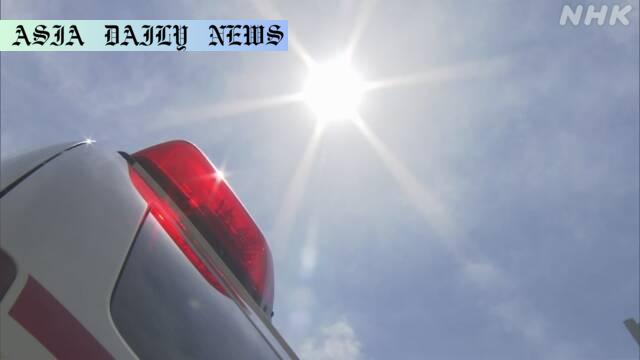Heatwave grips Japan’s regions with highs up to 39°C. Officials urge precautions to stay cool and avoid heat-related illnesses.
Dangerous heatwave persists across Japan.
Temperatures may reach up to 39°C in several cities.
Authorities issue heatstroke alerts in 36 prefectures.
Officials recommend air conditioning, fluids, and hydration.

Heatwave Grips Japan: Scorching Temperatures Raise Concerns
A severe and dangerous heatwave continues to engulf wide areas of Japan, stretching from the northeastern Tohoku region to the western Chugoku region. Meteorological predictions indicate record-high temperatures in many parts of the country, leaving authorities and residents bracing for prolonged heat-related impacts. With daytime highs forecasted to touch 39°C in multiple cities, including Tottori, Maebashi, and Toyooka, the heatwave is testing Japan’s preparedness and resilience. Meanwhile, other cities such as Kyoto, Yamagata, and Fukui are also set to experience extreme conditions, with temperatures surging up to 38°C.
Central Tokyo, Nagoya, Toyama, and Osaka are not far behind, with forecasted highs hovering around 36–37°C. In total, 36 prefectures, from Tohoku in the north to Okinawa in the south, have been put under official heatstroke alerts, signifying the severity and widespread nature of this heatwave. Despite the challenges posed, local authorities are working diligently to inform and protect citizens, underscoring the importance of preventive measures during such harsh weather conditions.
Mitigating Risks: Guidance to Stay Safe Amid Extreme Heat
Heatwaves such as these are no stranger to Japan, but their impact seems to be intensifying in recent years. Officials are urging residents to take proactive steps to avoid heat-induced illnesses, emphasizing the critical role of hydration, nutrition, and cooldown measures. Staying indoors during peak heat hours, consuming adequate fluids, using air conditioners, and wearing light clothing are some of the recommendations. Additionally, carrying electrolyte solutions can be beneficial in maintaining the body’s salt balance, which is crucial to offsetting dehydration risks during prolonged exposure to the heat.
Schools, workplaces, and many public organizations are implementing policies to safeguard individuals, including adjusted work timings, designated cooling zones, and regular breaks for workers who must be outdoors. Local governments have also activated emergency response teams to provide relief and medical assistance for those affected by heatstroke or worsening conditions.
Broader Impacts of Heatwaves: A Looming Climate Crisis
An unrelenting heatwave of this nature not only has immediate consequences but also highlights a broader, more complex challenge: climate change. Rising global temperatures have been linked to an increase in the frequency and duration of extreme weather events such as this. It is a sobering reminder of the urgent need for sustainable practices and climate adaptation strategies to mitigate these adverse effects. Japan, along with other nations, must continue to advance its energy efficiency, renewable energy transition, and public awareness campaigns to combat these growing challenges effectively.
This heatwave poses direct risks to vulnerable populations, including the elderly, children, and outdoor laborers. The higher ambient temperatures also affect agriculture, water availability, power grids, and healthcare systems. With consecutive days of sweltering weather projected, continuous adaptation and swift implementation of short- and long-term measures will be critical to saving lives and minimizing disruptions caused by such heat events.
Commentary
The Human Impact of Scorching Temperatures in Japan
The ongoing heatwave in Japan reveals the stark realities of managing extreme weather conditions in a densely populated and diverse landscape. Witnessing reports of daytime highs soaring to 39°C and heatstroke alerts spanning 36 prefectures reminds us of how vulnerable communities can be during such times. The immediate focus on safety measures, such as using air conditioners and staying hydrated, reflects the essential actions needed to mitigate risks. However, one cannot ignore the plight of individuals with limited access to these facilities, highlighting socioeconomic disparities during natural crises.
Adapting Cities to Withstand Extreme Heat Events
Looking at urban centers such as Tokyo, Osaka, and Nagoya, it becomes apparent that modern cities are often unprepared to handle extreme climate fluctuations. The heat-retention characteristics of concrete jungles exacerbate temperatures, creating urban heat islands where conditions are even harsher for residents. As cities grow, urban planners should prioritize heat-resistant infrastructure, such as reflective materials, abundant greenery, and integrated cooling systems. Policies that emphasize heatwave preparedness could play a critical role in protecting public health and urban sustainability.
A Call to Action Amid a Changing Climate
The heatwave is a glaring reminder of the significant role climate change plays in our daily lives. As temperatures rise across the globe, it is evident that such extreme events will occur more frequently, testing the limits of human resilience and infrastructure. Policymakers, scientists, and citizens alike must collaborate to address the challenges posed by global warming. Japan, with its advanced technology and innovation capabilities, is well-positioned to lead by example. However, achieving a sustainable response requires not just advanced tools but also widespread public engagement and behavioral shifts to build a better-equipped society for future generations.


